|
Top Ten US Navy Submarine Captains in WW2 By Number of Confirmed Ships Sunk
see the picture page
Introduction.
In looking at the top 10 US Navy Submarine Captains in WW2, I propose to change the process I used when the top 10 German U-Boat Captains were listed ie, by total tonnage sunk. In this exercise I will use the Confirmed number of ships sunk as my yardstick. In the case of the US Navy, the number of ships credited to each Captain, and the tonnage these ships represented were all reappraised post war, by the Joint Army-Navy Assessment Committee ( JANAC ) and were, in most cases, decimated. After each of the US Captains of Submarines, I will show both figures. (See "The Top Ten German U-Boat Aces of World War 2")
It is quite impossible to fairly compare the performance of the German U-Boat arm, to the results gained in the Pacific war by the US Navy's Submarine service. So many variables obtained, for instance:
1. The geographic areas differed.
For Germany, the Atlantic was a continuous stream of convoys going both east to west and vice versa. Targets were always available. For the USN, the vast Pacific gave the Japanese ships an enormous area over which to operate. Targets had to be searched for and found.
2. The weather.
The Atlantic Ocean must be one of the harshest oceans of the world in which to operate Merchant ships with their Escorts, and the U-Boats pitted against them. In the Pacific Ocean, its very name says it all.
3. The anti-submarine forces involved guarding the convoys.
The U-Boats had against them the most efficient anti-submarine force in the world. The Royal Navy, and its escort ships with their Hunter Killer Groups. The US Submarines pitted against the least efficient anti-submarine force in the world, the Japanese escort ships, not even fitted with radar.
Some US statistics relating to the Submarine war in the Pacific for WW2.
The US Navy and its Submarine arm, over WW2 in the Pacific, claimed to have sunk 4,000 Japanese ships to add up to a gross tonnage of 10 Million tons. Post war, the Joint Army-Navy Assessment Committee ( short title JANAC ) reassessed all these claims that had been credited to the individual Captains and their submarines, and amended them to read:
1,314 ships sunk, to add up to a gross tonnage of 5.3 Million tons, ie slicing the tonnage of ships sunk to almost half that originally credited.
The down side of this reassessment was the fact that the credited tonnage had been used as a basis to award the medals for their achievement to the Submarine Aces of the USN. Notwithstanding the lesser figure now allowed to those members of the Submarine service, it was a significant result, the submarine arm of the USN had about 16,000 seagoing personnel. They made up some 1.6% of the US Navy, but had accounted for 55% of the Japanese Maritime losses.
Losses in the Submarine service in WW2.
375 Officers and 3,131 enlisted men died in their submarines, that is a figure of 22% loss, the highest for any branch in all the US services.
Losses in the Japanese Merchant Navy.
Japan began the war with some 122,000 serving in her Merchant Navy, of these, 22,000 were killed, and 89,000 wounded. From these totals, US Submarine actions were responsible for 16,200 killed, and 53,400 wounded.
Defects in the US Navy torpedoes.
The US Submarine service, its Captains and crews were simply castrated by the defects in the torpedoes provided by their Bureau of Ordnance, and with which they were sent off to fight a ruthless enemy. They often ran deeper than the preset depth, and so passed too deep under a target.
The US torpedo used two methods to explode the warhead the torpedo carried:
1. A contact pistol.
Like its name it was designed to operate on impact with the target, when torpedoes actually ran at the correct depth, they many times failed to operate when the taget was actually hit.
2. A magnetic pistol.
Designed to activate when triggered by the target's magnetic field just when the torpedo was running under the ship's bottom. It often activated before reaching its target. Deactivate the magnetic exploder, and the contact pistol was also defective, each problem tended to be masked by the other. The Captains reported that their torpedoes were hitting targets and not exploding, or their torpedoes were missing.
NO ONE AT THE BUREAU OF ORDNANCE LISTENED.
Captains were told to get in closer to their targets before firing a spread. This backing and filling went on for an unbelieveable 23 months after Pearl Harbor, it took that long to fix the problems in the US torpedo, and before SUB Captains had a viable weapon at their disposal. It was one of the worst scandals of the USN in WW2.
Number of Torpedoes fired in WW2.
To sink the 1,314 ships in the Pacific in WW2, an amazing 14,748 torpedoes were fired.
The Top Ten US Navy Submarine Captains in WW2.
|
1. Richard H. O'Kane.
Final Rank: Rear Admiral.
Born Dover, New Hampshire 2nd. of February 1911. Graduated US Naval Academy 1934. He served in the cruiser USS Chester, and the destroyer USS Pruitt, and then in 1938 trained as a Submariner. In 1942, Richard served in the submarine Wahoo as her executive Officer.
As a Lieutenant Commander, he was Captain of the submarine USS Tang, and made five patrols in her. They were all made from his base at Pearl Harbor.
Patrol 1. January 1944 for 44 days in the Marianas. Results, 5 ships sunk.
Patrol 2. March 1944 for 61 days to the Palau area, and it was totally uneventful but Tang did rescue 22 airmen and take them to Hawaii at the conclusion of the patrol
Patrol 3. June 1944 for 36 days to the East China Sea. Results, 10 ships sunk, his best patrol.
Patrol 4. August 1944 for 34 days, again to the East China Sea. Results, 2 ships sunk.
Patrol 5. September 1944 , his submarine lost to an accident off China on 24th./25th. of October 1944. One of his torpedoes came back on a circular course to sink his boat Tang. Richard O'Kane became a Prisoner of War of the Japanese until the war ended. Results, 7 ships sunk before losing his submarine.
Award of Medal of Honor.
On release from POW camp, was awarded the Medal of Honor.
The top US Submarine Captain of WW2.
Richard O'Kane was credited with sinking 31 ships to total 227,800 tons, the best result.
Janac results: O'Kane's credited wartime results were scaled down to: 24 ships sunk to total 93,824 tons.
He made Captain in July 1953, to retire as a Rear Admiral in July of 1957. Richard died on the 16th. of February 1994.
Dick O'Kane was honoured by naming DDG 77 USS O'Kane after him.
|
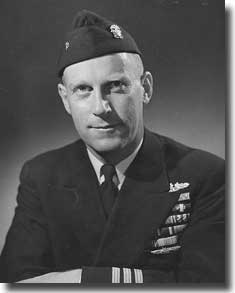
Commander Richard O'Kane. 1946
|
|
2. Slade D. Cutter.
Final rank: Captain.
Graduated from theNaval Academy 1935, he had been an all American Football star, and was on the boxing team. Served in the battleship USS Idaho, and was a wartime crew member of the submarine USS Pompano.
He took command of the submarine USS Seahorse, making three patrols in her. The first two out of his base at Pearl Harbor, the third ex Brisbane Australia.
Patrol 1. January 1944 for 41days to the Palau area. Results, 5 ships sunk.
Patrol 2. March 1944 for 56 days towards the Brisbane area. Results, 5 ships sunk.
Patrol 3. June 1944 for 47 days towards the Pearl Harbor area. Results, 4 ships sunk.
Slade was credited with sinking 21 ships to total 142,300 tons.
Janac results: Cutter's credited wartime results were scaled down to 19 ships to total 72,000 tons.
Post war he took an Armed Forces team to the London 1948 Olympic Games, where he referereed boxing. Slade Cutter commanded USS Northampton when she was the flagship of the Second Fleet. In the late 50's he served as Director of Athletics at the Naval Academy, Annapolis.
Awards.
For his achievements, Slade Cutter was awarded the Navy Cross four times.
|
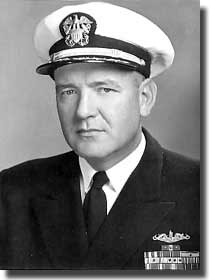
Slade D Cutter
|
|
3. Dudley W. Morton.
Final rank: Lieutenant Commander.
Born Owensboro, Kentucky 17th. of July 1907. Graduated Naval Academy 1926. Served in the carrier USS Saratoga, and the heavy cruiser USS Chicago.
In 1933 Dudley trained to serve in Submarines, and was Commanding Officer of the small boat R5. In 1942, he was appointed as a Lieutenant Commander to take command of the submarine USS Wahoo, making five patrols in her, the last one proving fatal. The first of these, ex Brisbane Australia, and all the other patrols from his base at Pearl Harbor.
Patrol 1. January 1943 for 23 days towards Pearl Harbor. Results, 3 ships sunk.
Patrol2. February 1943 for 42 days in the East China Sea area. Results, 9 ships sunk.
Patrol 3. April 1943 for 26 days in the Empire of Japan area. Results, 3 ships sunk.
Patrol 4. August 1943 for 27 days in the Empire of Japan area. Results, no sinkings achieved.
Patrol 5. September 1943, Wahoo lost on this patrol. Results, 4 ships sunk prior to being sunk herself.
Dudley Morton's was credited with sinking 17 ships to total 100,500 tons.
Janac results: Morton's credited wartime results were changed to 19 ships sunk, but the tonnage was scaled down to 55,000 tons.
Awards.
For his achievements, Dudley Morton was awarded the Navy Cross four times, the last one postumously. Wahoo was awarded a presidential Citation.
|
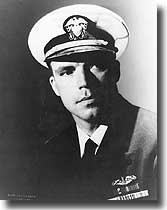
Lt Cdr Dudley W Morton 1943
|
|
4. Eugene B. Fluckey.
Final Rank: Rear Admiral.
Born Washington DC. 1913. Graduated Naval Academy 1935. Served in the battleship USS Nevada and the destroyer USS McCormick.
Joined the Submarine service in 1938, and was a crew member of the submarine USS Bonita, in which he carried out 5 war time patrols. On the 22nd. of April 1944 took command of USS Barb and in her, made a further five patrols from his Pearl Harbor base.
Patrol 1. May 1944 for 49 days making a polar circuit. Results, 5 ships sunk.
Patrol 2. August 1944 for 59 days in the Luzon Straits. Results, 3 ships sunk.
Patrol 3. October 1944 for 30 days in the East China Sea. results, 2 ships sunk.
Patrol 4. December 1944 for 56 days, again in the East China Sea. Results, 4.5 ships sunk.
Patrol 5. January 1945 for 54 days in the Empire of Japan area. Results, 2 ships sunk.
Eugene Fluckey was credited with sinking 25 ships to total 179,700 tons.
Janac results, Fluckey's credited wartime results were scaled down to: 16.3 ships to total 95,360 tons.
Note: Although this tonnage sunk is greater than that achieved by Richard O'Kane, the order of the top 10 US Submarine Captains was decided by the number of ships sunk, and not by the total tonnage sunk. This is the reason that Eugene Fluckey is rated as No. 4, and not No. 1 Ace.
Post war, this officer was appointed Commander Sub Force US Pacific Fleet from June 1964- June 1966. He retired as a Rear Admiral in 1972.
Awards.
Four Navy Crosses. Medal Of Honor. Unit Presidential Citation two times. Eugene B. Fluckey is listed as having been awarded the most wartime decorations of any living American veteran.
I am indebited to Richard Latour for additional information, and the date that Commander Fluckey took command of Barb.
|
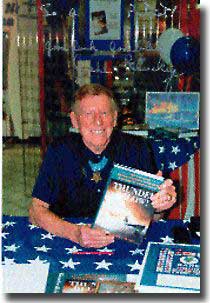
Rear Admiral Eugene B Fluckey.
A recent photograph.
|
|
5. Samuel D. Dealey.
Final Rank: Commander.
Born on the 13th. of September in Dallas Texas. Graduated Naval Academy 1930. Served in the battleship USS Nevada before training as a Submariner.
He took command of the submarine USS Harder on the 2nd of December 1942. He made six patrols, the first four from his Pearl Harbor base, then took his boat to Western Australia to be based at Fremantle, and from here he made two more patrols, and was lost on the last patrol.
Patrol 1. June 1943 for 43 days in the Empire of Japan area. Results, 1 ship sunk.
Patrol 2. August 1943 for 46 days in the Empire of Japoan area. Results, 2 ships sunk.
Patrol 3. October 1943 for 31 days in the Marianas area.Results, 3 ships sunk.
Patrol 4. February 1944 for 47 days in the area towards Fremantle. Results, 2 ships sunk.
Patrol 5. May 1944 for 45 days in the Celebes area. results, 3 ships sunk.
Patrol 6. August 1944. In the area of Luzon. Results, 5 ships sunk, before being sunk by depth charges on the 24th. of this month.
Dealey was credited with sinking 20.5 ships to total 82,500 tons.
Janac results. Samuel Dealey's wartime results were reduced to 16 ships sunk to total 54,002 tons.
A Destroyer Escort, USS Dealey, to honour the memory of Commander Samuel D. Dealey USN. was launched, sponsored by his widow, on the 8th. of November in 1953.
Awards.
The Medal of Honor. Four Navy Crosses. The Silver Star. Unit Presidential Citation.
|
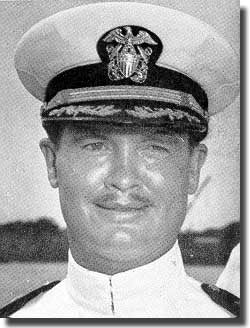
Commander Samuel Daley
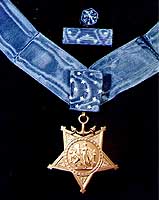
Navy medal of Honor.
Awarded to Samuel D Dealey. Captain of USS Harder, sunk by depth charges on her 6th, patrol off Luzon on 24th. of August 1944.
|
|
6. Rueben T. Whitaker.
Final Rank: Rear Admiral.
Graduated from the Naval Academy 1934. Rueben Whitaker was the exective Officer in the Submarine USS Sturgeon when the US declared war on Japan. The boat was at Pearl Harbor, and his Captain, William Leslie Wright enjoyed whiskey, and revelled in relating tall stories after a few of his favourite drinks, hence his nickname " BULL. "
After a night on the grog, he was in no state to go to sea, Whitaker prepared the ship for sea, aided by Chester Nimitz, the 3rd. officer on board, ( he was the son of the famous US wartime Admiral ) Whitaker took the submarine out of Pearl Harbor, and dropped anchor well out into Manila Bay.
The submarine USS Flasher was launched on the 20th. of June 1943 sponsored by Mrs W. A. Saunders. She commissioned on the 25th. of that year with Lieutenant Commander Reuben T. Whitaker appointed in command. She arrived at Pearl from New London on the 15th. of December 1943. In January 1944 Whitaker piloted his boat out of harbour for her first patrol. The remaining patrols under Whitaker were all made out of Fremantle,
Western Australia.
( at that time I was serving in the Australian light cruiser HMAS Adelaide, an Australian Army despatch rider's motorcycle ex Singapore had been acquired from mates in the Dutch Cruiser Tromp, with two other young officers in the Adelaide, I shared the ownership of this motor bike. The Captain of the US Submarine Depot ship in Fremantle, and our Commander were very friendly.We acquired a 44 gallon drum of petrol now and then by courtesy of the US Sub Depot ship, which allowed us to run the bike when we had a break from our escort duties in the Indian Ocean. I thus had reason to be thankful for the stationing of US submarines at Fremantle in 1944. )
Patrol 1. January 1944 for 53 days in the area off Mindoro. Results, 4 ships sunk.
Patrol 2. April 1944 for 54 days in the South China Sea. Results, 3 ships sunk.
Patrol 3. June 1944 for 49 days, again in the South China sea. Results, 4.5 ships sunk.
Patrol 4. September 1944 for 51 days in the Manila area. Results, 3 ships sunk.
Note: You may well ask how do you sink a half of a ship. This means the kill was shared with another submarine.
Whitaker was credited with sinking 18.5 ships to total 111,500 tons.
Janec results. Rueben Whitaker's war time results were reduced to 14.5 ships to toal 60,846 tons.
Whitaker now handed over his submarine to Lieutenant Commander G.W. Grider. This boat was decommissioned post war on the 16th. of March 1946. Note: This submarine was named after a large edible fish of the same name, known as a triple tail, found in the Western Atlantic from Cape Cod to South America.
Awards.
Three Navy Crosses. Unit Presidential Citation for the outstanding 3rd. 4th. and 5th. Patrols.
|
|
|
7. Gordon W. Underwood.
Last Rank: Captain.
Born in New York on the 3rd. of June 1910. Graduated Naval Academy 1932. Served in USS Oklahoma, and trained for Submarines, and then served in the Submarine School's S-21, USS Mississippi, and USS Vega. In 1941 gained his Masters of Engineering at MIT, and served as Squadron Engineer with Submarine Squadron 10. Became Captain of USS Spadefish in January 1944 and made three patrols in her, all out of Pearl Harbor.
Patrol 1. July 1944 for 59 days in Luzon Straits area. Results, 6 ships sunk.
Patrol 2. October 1944 for 49 days in the East China Sea area. Results, 4 ships sunk,
including the 21,000 ton IJN Carrier Shinyo.
Patrol 3. January 1945 for 38 days in the East China Sea area. Results, 4 ships sunk.
On Patrol 3 whilst leading USS Submarines, Pompon, Bang, and Atule to the Yellow Sea, Spadefish and her consorts were attacked by a flight of US Navy aircraft. Two bombs were dropped before Spadefish could dive, but fortunately they did little damage. As a result of this incident, the Captain of Pompon, and Gordon Underwood both asked for transfers, and Underwood went off to the Bureau of Ships.
Underwood was credited with sinking 14 ships to total 89,600 tons.
Janac changed these figures to 14 ships sunk to total 75,386 tons.
Awards.
Three Navy Crosses.
Gordon Underwood made Captain and went on to serve 30 years in the Navy to retire in 1962. USS Underwood, a guided missile frigate, named in Captain Underwood's honour was commissioned on the 29th. of January 1983. Gordon, at the age of 67 died on the 5th. of July 1967.
|
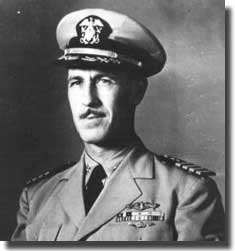
Gordon Underwood as a Captain |
|
8. Royce L. Gross.
Final Rank: Commander.
Graduated from the Naval Academy in 1930. After training in Submarine warfare Gross captained two boats to make 7 patrols, his first five in USS Seawolf, all out of Pearl Harbor, then as a Commander, he commissioned USS Boarfish on the 23rd. of September 1944. In her, he undertook two patrols, the first from Pearl, and the last one from Fremantle in Western Australia.
Patrol 1. April 1943 for 30 days in the East China sea area. Results, 2 ships sunk.
Patrol 2. May 1943 for 56 days, again to the East China Sea area. Results, 1 ship sunk.
Patrol 3. August 1943 for 32 days to East China Sea area. Results, 3 ships sunk.
Patrol 4. October 1943 for 53 days to the usual hunting ground of the East China Sea. Results, 2 ships sunk.
Patrol 5. December 1943 for 36 days, same area as the previous 4 patrols. Results, 4.5 ships sunk.
USS Boarfish.
Patrol 1. December 1944 for 52 days between Pearl Harbor and Australia. Results, 1.5 ships sunk.
Patrol 2. March 1945 for 42 days in the Indo China area. Results, nil. Royce Gross landed a Commando party near Hue on the coast of Indo China, and set a demolition charge on a nearby rail line, and thus was credited with derailing or damaging a train.
Royce Gross was credited with sinking 13.5 ships to total 80,500 tons.
Janac results, 14 ships to total 65,735 tons.
Notes: Gross with his seven patrols, made in two submarines, carried out the most patrols in the top 10 US Navy Submarine Captains. USS Seawolf under a new Captain, and on her 15th. patrol, was sunk by friendly fire on the the 3rd. of October 1944, as the result of a Hedge Hog attack by USS Rowell. 85 crew members died.
Awards.
The Navy Cross.
|
.
|
|
9. Charles O. Triebel.
Final Rank: Rear Admiral.
Born at Peoria, Illinois on the 17th. of November 1907. Graduated from Naval Academy in 1929. USS Snook was launched on the 15th. of August in 1942, and was commissioned on the 24th. of October that year, with Lieutenant Commander Charles Triebel in command.
Earlier, Charles whilst serving in USS Shark's shakedown cruise had visited Panama, when ashore he ran into trouble with some local thugs, and finished up having his throat cut, always to carry that scar.
He made five patrols in Snook, all from his Pearl Harbor base.
Patrol 1. April 1943 for 42 days in East China Sea area. Results, 3 ships sunk.
Patrol 2. June 1943 for 40 days returning to the East China Sea area. Results, 2 ships sunk.
Patrol 3. July 1943 for 52 days, again to the East China Sea area. Results, 2 ships sunk.
Patrol 4. October 1943 for 38 days in the Marianas area. Results, 2 ships sunk.
Patrol 5. November 1943, back to his main stamping ground, the East China Sea area. Results, 4.5 ships sunk.
Charles Triebel had a lot of problems with his torpedoes, and was most outspoken about the dereliction of duty by the Bureau of Ordinance in his correspondence, but he was protected by his Submarine Commander, Rear Admiral Lockwood, by not forwarding all his critical remarks up the line. Although Lockward did try to act on behalf of his Submarine Captains, and eventually was instrumental in fixing these torpedo defects, but as I commented earlier, it took an inordinate time to correct these problems.
Triebel was relieved of his command and was sent off to the Bureau of Ordinance, where he served out the war.
Charles Triebel was credited with sinking 13 ships to total 83,300 tons.
Janas changed these results to read 14 ships sunk to total 58,837 tons.
Awards.
Three Navy Crosses.
Note. On her 9th. patrol USS Snook was lost with her 84 crew members in the Luzon Strait Area.
|
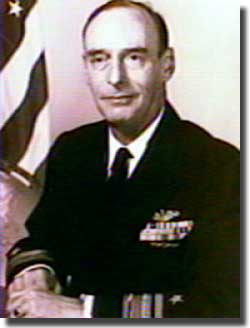
Charles O Triebel, 1959
|
|
10. John S. Coye Jr.
Final Rank: Rear Admiral.
Born on the 24th. of April 1911 at Berkeley, California. Graduated Naval Academy in 1933. After his submarine training he commanded R-18, and was eventually appointed to USS Silversides in command. She had been launched at Mare Island Naval Yard in California, on the 26th. of August 1941, named after a species of fish, to commission on the 15th. of
December 1941, close to Pearl Harbor Day.
Coye made three patrols in Silversides, two out of Pearl Harbor and one from Fremantle.
Patrol 1. July 1943 for 53 days to the Bismarck Sea area. Results, 4 ships sunk.
Patrol 2. October 1943 for 36 days to the Philippines area. Results, 4 ships sunk.
Patrol 3. April 1944 for 47 days towards the area of the Philippines. Results, 6 ships sunk.
John Coye served for 35 years in the US Navy, post war he commanded a heavy cruiser, and spent time with NATO.
His life long hobbies included playing organ music and sailing his Cal 25 boad Sea Dog. In 1975 he was Commodore of the Coronado Yacht Club. He died at age 91 on the 26th. of November 2002, leaving 5 grand children and 2 great grand children.
John was credited with sinking 14 ships to total 71,700 tons.
Janac reduced these results to 14 ships to toal 39,000 tons.
Awards.
Three Navy Crosses.
Note.
USS Silversides is preserved and is now on display at Muskegon, Michigan in their Great Lakes Naval Memorial Museum.
|
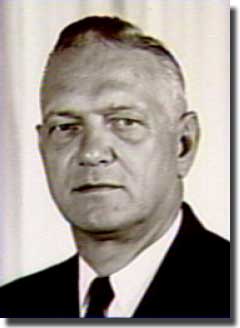
John Coye Jr. 1961
|
Awards to the top 10 US Submarine Captains, and Unit Presidential Citations.
Medal of Honor.
Three times, to Richard O'Kane, Eugene Fluckey and Samuel Dealey.
Navy Cross.These 10 Captains between them were awarded the Navy Cross an amazing 29 times.
Silver Star.
Once, to Samuel Dealey.
Unit Presidential Citation.
Four times, to USS Wahoo, USS Barb, USS Harder, and USS Flasher.
Final rank reached by the top 10 US Navy Submarine Captains.
Rear Admiral.
Five reached the flag rank of Rear Admiral.
Captain.
Two were Captains.
Commander.
Two became Commanders.
Lieutenant Commander.
There was only one Lieutenant Commander, Dudley Morton, who was killed when his boat was sunk.
|
|
|









